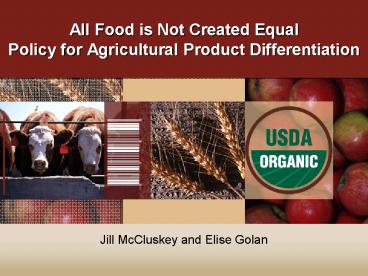Jill McCluskey and Elise Golan - PowerPoint PPT Presentation
1 / 14
Title:
Jill McCluskey and Elise Golan
Description:
Asymmetric information (search, experience, and credence goods) ... Psychological economics (Placebo effect in credence goods?) Behavioral economics ... – PowerPoint PPT presentation
Number of Views:108
Avg rating:3.0/5.0
Title: Jill McCluskey and Elise Golan
1
All Food is Not Created EqualPolicy for
Agricultural Product Differentiation
- Jill McCluskey and Elise Golan
2
Role of Government in Changing Food Markets
- Explosion of differentiated products
- new demands
- new technologies
- new industry structures
- New role for Government?
3
Justification for Government Intervention
- Farmers fear of exploitation by buyers
- onerous, egregious, and downright illegal
requirements by buyers - growing power of retailers - slotting fees,
private label, etc - Consumer concerns (credence attributes)
- is food safe? (bioterrorism)
- does advertised attribute exist?
- Unfair competition (fraud)
- Napa Valley wine from China
4
More Justification
- Facilitate trade by reducing search and
transaction costs - too much information (cell phones and nutrition)
- Social objectives
- fair trade, sustainable, free range, slow, etc.
- Too much differentiation (the anti-justification)
- spatial models suggest too much product
differentiation - utility is non-monotonic in choice
5
Policy Intervention Grades and Standards
- How are mandatory grades and standards set?
- objective safety considerations
- producer driven?
- political/consumer driven?
- Do they improve the market outcome?
- unsure because of multiple and confounding market
failures - not usually but more likely when quality
differences are great and difficult to detect - insane for government to help producers to
differentiate
6
Policy Intervention Certification and
Accreditation
- Certifying private standards
- high quality justifies intervention?
- Certifying the certifiers
- Certifying testing methodologies
7
Policy Intervention Information
- Reveal safety inspection information
- Change consumer behavior? Maybe
- Change firm behavior? Probably
- Reveal nutrition information
- Change consumer behavior? Maybe
- Change firm behavior? Probably
- Information least distortionary intervention?
- Cost/benefit evidence?
8
Policy Intervention Help Consumers Make the
Right Choices
- Help consumers interpret information
- smarter consumers - education programs
- smarter information - labeling and adverts
- Restrict choice (choice is making us fat)
- Paternalism (food assistance programs)
- Libertarian paternalism (food defaults)
- Expand choice (tyranny of the majority)
- stimulate effective demand (WIC)
- subsidize farmers markets, etc.
- Construct choice?
9
Research Directions
- Policy
- Mandatory versus voluntary compliance with
standards - Who chooses standards, who monitors government
(which agency?) or private group - International trade barriers to trade vs.
consumer sovereignty. - Free-riding in state agricultural products
- Information overload and scarcity of label real
estate - How product differentiation at the retail level
filters down through the food system, e.g. farmer
to retailer obstacles. - Cost-benefit analysis
- Valuation
- Revealed vs. stated preferences
- Choice experiments vs. contingent valuation
- Effects of information supplied to survey
participant. - Theory
- Asymmetric information (search, experience, and
credence goods) - Heterogeneity of not well modeled from a consumer
point of view (e.g. representative consumer
models) - Psychological economics (Placebo effect in
credence goods?) - Behavioral economics
10
Valuation Issues Revealed vs Stated Preferences
- Policy makers often must make decisions based on
non-market valuation estimates. - RP techniques are based on actual behavior but
are indirect and sensitive to model
specification. - SP techniques are direct but hypothetical.
11
Revealed vs. Stated preferencesConsistency
Across Approaches?
- Intuitive definition of consistency revealed
preferences agree with stated preferences. - Statistical definitions of consistency are
- Complete consistency equal parameters and equal
variances. - Partial consistency equal parameters, but
differences in terms of variances
12
Example Survey vs. Experiment
- Numbered coupons were linked to numbered surveys.
- 2 Step model approach
- model stated preferences with a double-bounded
model. - model actual behavior as a function of stated
preferences and other attributes and
socio-economic characteristics. - Test whether consumers acted consistently in the
market experiment with their stated preferences. - Respondents with higher stated WTP were more
likely to actually purchase the product.
13
Valuation Effects of information supplied to
survey participants
- Studies show individuals place a greater weight
on negative information than on positive
information. - However, benefit information has a statistically
significant effect on WTP for GM foods. - Information provision has greater effects for
particular groups of consumers. - Source information matters.
14
Additional Research Directions
- Free-rider effect
- branded vs. minimum quality standards
- whats the threshold size to stop imposing
standards? - Differentiation by package size
- may explain quantity surcharges
- Psychology and economics
- Placebo effect utility depends on beliefs






























![[PDF⚡READ❤] JILL DUGGAR: The Iconic Biography of American Reality Star from '19 Kids and PowerPoint PPT Presentation](https://s3.amazonaws.com/images.powershow.com/10062854.th0.jpg?_=20240624072)
